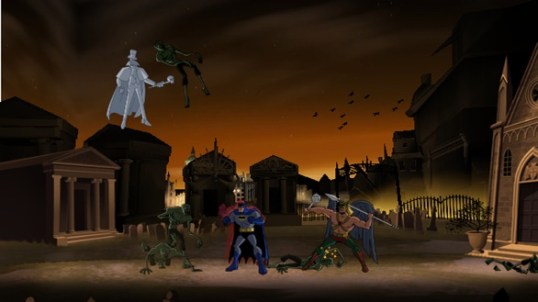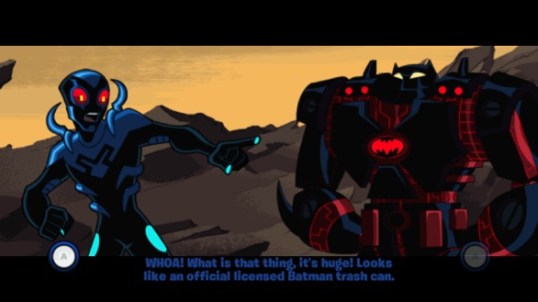Batman’s been entertaining generations of comic-book readers, TV watchers and movie viewers. He’s been in tons of video games, too, but it’s only been until recently that the games have actually been good. Last year’s Batman: Arkham Asylum gave players a grim vision of the Dark Knight and his world, which got widely acclaimed as the best superhero game ever. This year’s Bat-game goes in a radically different direction, adapting the brighter and more comedic Batman: The Brave and the Bold show on Cartoon Network. The series riffs on the old Batman team-up comic, which paired the Caped Crusader up with various other heroes from the DC Universe. The Wii-exclusive title follows the same structure and lets two players fight crime in Gotham City and beyond. Adam Tierney–the designer at the WayForward dev studio that directed the game–answered some questions about Batman’s newest video game adventures.
What’s the secret origin of the WayForward development studio? Do you know what it was in your pitch or previous work that won you the B&B gig?
Unfortunately our company’s secret origin doesn’t involve slipping into a vat of toxic waste or being orphaned on an alien planet. WayForward was founded by Voldi Way (our President and “Tyrannical Overlord”) about 20 years ago. We began by creating CD-Rom games with an emphasis on educational entertainment. Then in 2002, we released Shantae on the GameBoy Color through Capcom. It was one of the best-received titles on that system, notable for its old-school gameplay sensibilities and beautiful character animation. Since then we’ve gone on to work on titles such as Contra 4, LIT, and A Boy and his Blob. No matter what the project, whether it’s licensed or original, we always place an emphasis on classic gameplay mechanics, challenging difficulty, impressive animation, and relatable characters.
Batman: The Brave and the Bold the Videogame was right up our alley, because the TV cartoon focused on these same core elements. Our pitch to Warner Bros. Interactive Entertainment highlighted that gamers would be able to “play the cartoon.” We didn’t want this to feel like a typical videogame adaptation. We wanted the player to feel as if they were directly controlling the TV program they tuned into each week. Warner Bros. Interactive Entertainment liked the approach, and after a few documents, demos, and presentations, we landed the gig for both the Wii and Nintendo DS games.
I love the running dialogue between Batman, Robin and the other heroes during gameplay. What made you guys have banter between the playable characters?
It just goes back to the idea of translating the show to game form, rather than adapting it. The game is broken into four brand new “game episodes,” each with the same structure as an episode of the cartoon. We didn’t want to fall into the usual pattern of chatty cutscene, followed by silent gameplay. So instead, we have the story constantly unfolding during the gameplay, just as it does in the TV show. Batman and his playable partner (who differs in each episode) banter back and forth for comedy, but they also make observations and decisions that drive the story. This gives the player the impression that they’re actually piloting the characters from the show, rather than navigating around a bland avatar.
Why do you think people who loved the grittier, more violent take on Batman that Rocksteady delivered on Arkham Asylum should pick up Brave and the Bold?
Well first off, I’m in that crowd! Batman: Arkham Asylum is an incredible game, almost unquestionably the greatest superhero game ever made. Gamers expecting the same dark, adult take on the character in this game are in for a bit of a surprise, though. Batman: The Brave and the Bold the Videogame is a younger, sillier, more fun interpretation of the Caped Crusader. It’s a little surprising at first, but I’d challenge any true Bat-fan to check out an episode or two of the show and not be won over by its smart writing and hilarious dialogue.
Even though the game is targeted to a younger audience and based on a younger property, we made sure there’s plenty of depth for fans of all ages and Batman in general. The game is essentially a hybrid between an old school brawler (ala Double Dragon II) and a fighter (Street Fighter II). The player can attack, grab, and hurl enemies into one another, or toss them into the air and leap up after them for some mid-air juggling. And there’s a huge emphasis on teamwork, just like in the show, so players are able to coordinate their attacks, and even toss enemies back and forth.
The more powerful combat moves are more challenging to pull off, and the player is rewarded with faster upgrades based on how quickly they’re able to defeat enemies. So although the core gameplay is easier to pick up than that of Batman: Arkham Asylum, the combat systems run pretty deep for those willing to take the time to master them.
Which DC character do you love on the Brave & the Bold show? And which was the most fun to use in the game?
Oh boy, where to begin? The show is a DC Comics fan’s dream, with cameos from just about everyone under the label. It’s also a celebration of characters that typically don’t take the spotlight. If I had to pick one favorite, it would definitely be Guy Gardner (a member of the Green Lantern Corps). He’s typically forced to play second fiddle to Green Lantern Hal Jordan in the comics, and he has a major chip on his shoulder because of that. He’s also a bit of a hothead, so teaming him up with the cool, calculating Batman makes for one of the game’s most memorable team-ups.
Guy was a lot of fun to create, because of his incredible ring constructs, which can be directed anywhere onscreen. At the same time, balancing Robin was interesting, because he’s so spry and quick compared to the other heroes. His shock attack gadget is probably my favorite weapon in the game; it involves him vaulting over an enemy while simultaneously planting a timed electrical charge on their back. After that’s done, the enemy becomes a walking time bomb that can be kicked or thrown into any other enemies. It’s a very acrobatic attack that matches his personality perfectly.
What do you think it is about Batman that allows him to be interpreted in so many different ways throughout the decades?
Batman is the defining dark hero of modern comics, and really of all forms of media. His story is so pure and almost fable-like (an orphaned child who dedicated his life to stopping crime) that the specifics of him can be adjusted to fit whatever era he’s currently a part of. You had the sillier interpretations of Batman in the 1960s, the brutal, dark versions of the 1980s, and now (with this game) you get a blend of everything.
So few games offer interoperability between the DS and the Wii. Why did you guys decide to implement the Batmite feature? Did you have to jump through any special hoops with Nintendo in order to implement the feature?
In the cartoon, Bat-Mite is the only character aware that he’s in a cartoon, so it made sense that he would be the only character aware that he’s in our videogame. Without spoiling it, we actually use Bat-Mite in a few different ways in the game, where he basically forces himself into the software to cause mischief. With the wireless connectivity feature, we decided to use the character’s magical abilities to create something completely unique for gamers that bought a copy of both the Wii and DS game.
Connecting the two versions allows a third player to control Bat-Mite in the Wii game, using the DS and stylus. As Bat-Mite, the player can fly anywhere onscreen, and drop health, energy, bombs, and anvils. These objects affect both heroes and enemies, so (just like the character himself) it’s up to the player whether to be a help to their friends, or a nuisance.
It was surprisingly easy to get that feature up and running. We had a very specific, simple design in mind, and one of our programmers (Daniel Kellogg) got the basic functionality working in just a few days. It’s surprising that more games out there haven’t featured this sort of Wii-to-DS connectivity. Nintendo responded very positively to the idea, and supported us in getting everything functional.
What other DC characters would you like to translate into a video game form?
To be honest, most of my dream characters made it into this game! I’ve been working on superhero games at WayForward for over five years, and if you told me that we’d be getting The Rogues, Guy Gardner and Booster Gold into one game, I never would have believed you! That’s what is so great about Batman: The Brave and the Bold the TV show: nearly every character in the DC Universe is fair game. You’re dealing with all sorts of heroes and villains, not just those typically associated with the dark knight.
Looking beyond the show’s roster, it would be pretty interesting to work on a game featuring characters from DC’s adult Vertigo imprint, like John Constantine, Shade, or the Endless. But that’s all I can really think of, since the bulk of the DC Comics mainstream roster was already made available to us on this game.
What are the special challenges you face in making a family-friendly game? Do you have to make the animation look a certain way or make sure the control scheme is relatively easy to pick up?
Absolutely. The greatest challenge in developing this game was creating an experience that was easy enough for young gamers to play, yet deep and challenging enough for the game enthusiast crowd, and Batman fans in general.
Ultimately we took an ‘easy-to-learn, difficult-to-master’ approach with the combat. To start, the game is low risk, with the player losing coins rather than lives each time their health is drained. Coins are earned by defeating enemies, and more coins are earned by defeating enemies rapidly, and in close succession. Collected coins are then spent on unlocking new gadgets, and upgrading existing gadgets, which give the players new attack maneuvers, or access to new areas in each stage. So younger gamers can fight their way through the episodes, and that’s enough challenge for them, while older gamers can strive to perform incredible chains of attacks, to earn the most points possible for their upgrades.
We made an effort to support both gamer types throughout the title, with our coin combo system, and with more advanced combat maneuvers (like air-juggling) that will appeal primarily to the advanced gamers. It’s a delicate balance, but I feel the end product is something that Bat-fans of all ages will be able to appreciate.



